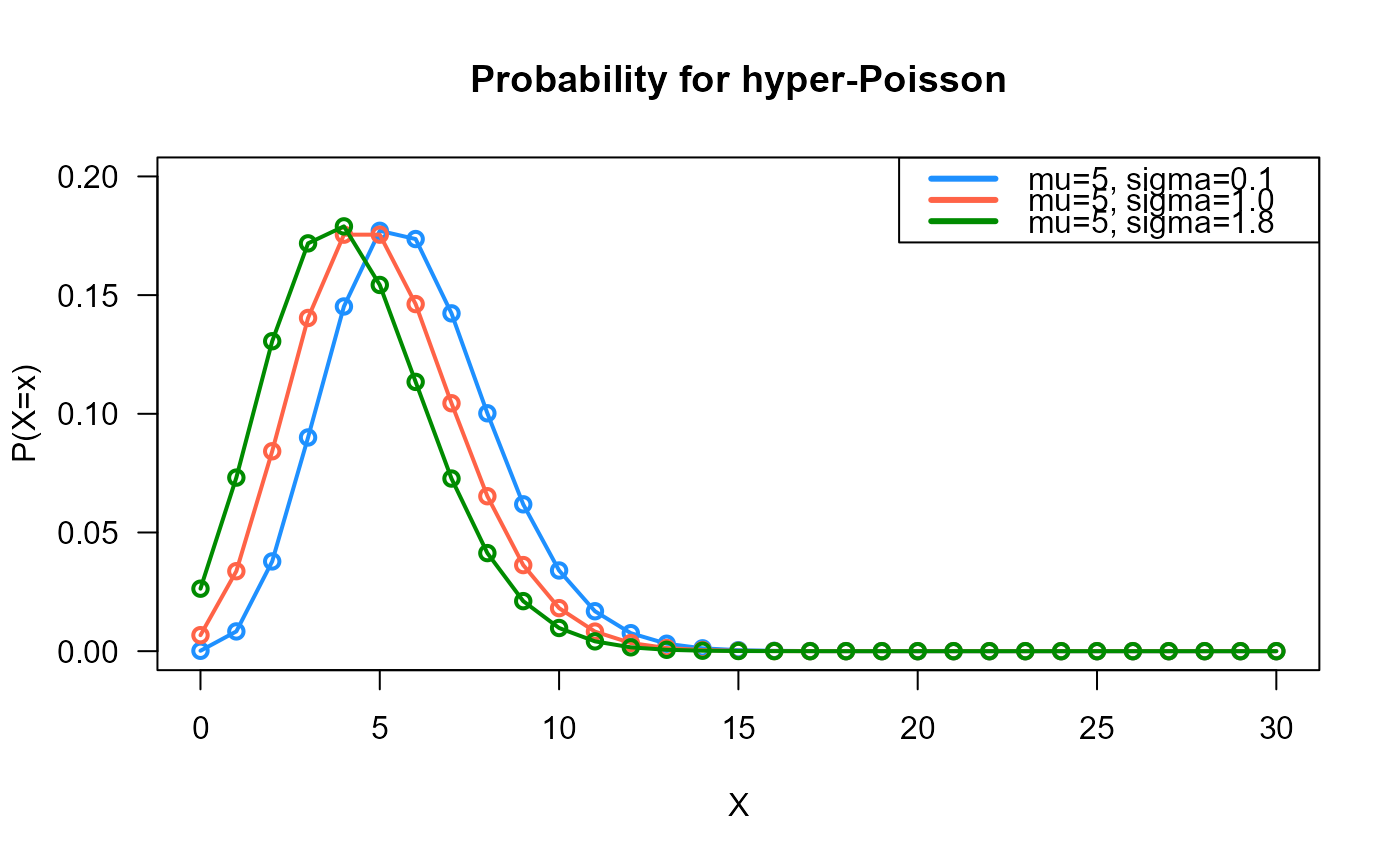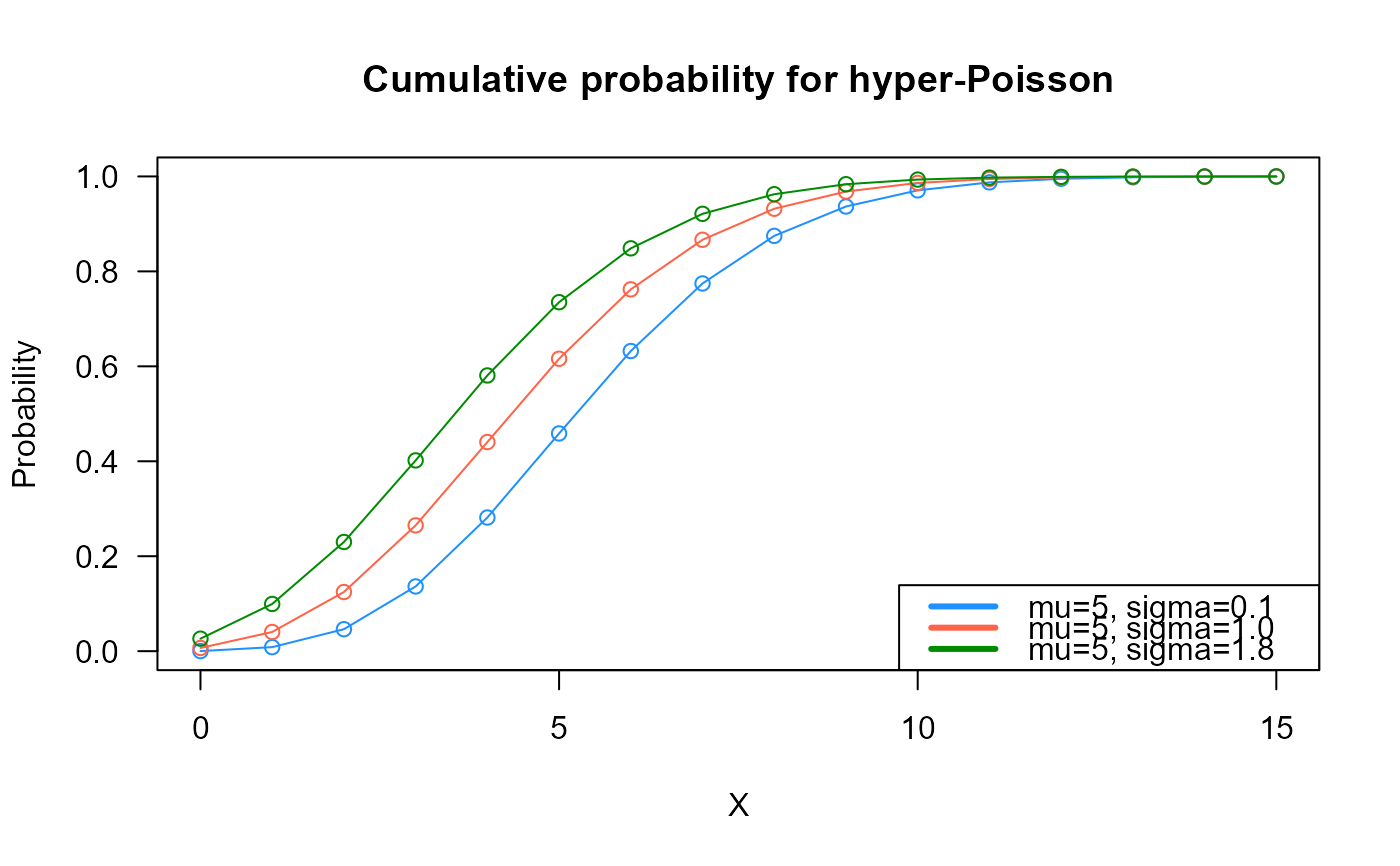These functions define the density, distribution function, quantile function and random generation for the hyper-Poisson, HYPERPO(), distribution with parameters \(\mu\) and \(\sigma\).
dHYPERPO(x, mu = 1, sigma = 1, log = FALSE)
pHYPERPO(q, mu = 1, sigma = 1, lower.tail = TRUE, log.p = FALSE)
rHYPERPO(n, mu = 1, sigma = 1)
qHYPERPO(p, mu = 1, sigma = 1, lower.tail = TRUE, log.p = FALSE)Arguments
- x, q
vector of (non-negative integer) quantiles.
- mu
vector of the mu parameter.
- sigma
vector of the sigma parameter.
- log, log.p
logical; if TRUE, probabilities p are given as log(p).
- lower.tail
logical; if TRUE (default), probabilities are \(P[X <= x]\), otherwise, \(P[X > x]\).
- n
number of random values to return.
- p
vector of probabilities.
Value
dHYPERPO gives the density, pHYPERPO gives the distribution
function, qHYPERPO gives the quantile function, rHYPERPO
generates random deviates.
Details
The hyper-Poisson distribution with parameters \(\mu\) and \(\sigma\) has a support 0, 1, 2, ... and density given by
\(f(x | \mu, \sigma) = \frac{\mu^x}{_1F_1(1;\mu;\sigma)}\frac{\Gamma(\sigma)}{\Gamma(x+\sigma)}\)
where the function \(_1F_1(a;c;z)\) is defined as
\(_1F_1(a;c;z) = \sum_{r=0}^{\infty}\frac{(a)_r}{(c)_r}\frac{z^r}{r!}\)
and \((a)_r = \frac{\gamma(a+r)}{\gamma(a)}\) for \(a>0\) and \(r\) positive integer.
Note: in this implementation we changed the original parameters \(\lambda\) and \(\gamma\) for \(\mu\) and \(\sigma\) respectively, we did it to implement this distribution within gamlss framework.
References
Sáez-Castillo, A. J., & Conde-Sánchez, A. (2013). A hyper-Poisson regression model for overdispersed and underdispersed count data. Computational Statistics & Data Analysis, 61, 148-157.
See also
Examples
# Example 1
# Plotting the mass function for different parameter values
x_max <- 30
probs1 <- dHYPERPO(x=0:x_max, mu=5, sigma=0.1)
probs2 <- dHYPERPO(x=0:x_max, mu=5, sigma=1.0)
probs3 <- dHYPERPO(x=0:x_max, mu=5, sigma=1.8)
# To plot the first k values
plot(x=0:x_max, y=probs1, type="o", lwd=2, col="dodgerblue", las=1,
ylab="P(X=x)", xlab="X", main="Probability for hyper-Poisson",
ylim=c(0, 0.20))
points(x=0:x_max, y=probs2, type="o", lwd=2, col="tomato")
points(x=0:x_max, y=probs3, type="o", lwd=2, col="green4")
legend("topright", col=c("dodgerblue", "tomato", "green4"), lwd=3,
legend=c("mu=5, sigma=0.1",
"mu=5, sigma=1.0",
"mu=5, sigma=1.8"))
 # Example 2
# Checking if the cumulative curves converge to 1
x_max <- 15
cumulative_probs1 <- pHYPERPO(q=0:x_max, mu=5, sigma=0.1)
cumulative_probs2 <- pHYPERPO(q=0:x_max, mu=5, sigma=1.0)
cumulative_probs3 <- pHYPERPO(q=0:x_max, mu=5, sigma=1.8)
plot(x=0:x_max, y=cumulative_probs1, col="dodgerblue",
type="o", las=1, ylim=c(0, 1),
main="Cumulative probability for hyper-Poisson",
xlab="X", ylab="Probability")
points(x=0:x_max, y=cumulative_probs2, type="o", col="tomato")
points(x=0:x_max, y=cumulative_probs3, type="o", col="green4")
legend("bottomright", col=c("dodgerblue", "tomato", "green4"), lwd=3,
legend=c("mu=5, sigma=0.1",
"mu=5, sigma=1.0",
"mu=5, sigma=1.8"))
# Example 2
# Checking if the cumulative curves converge to 1
x_max <- 15
cumulative_probs1 <- pHYPERPO(q=0:x_max, mu=5, sigma=0.1)
cumulative_probs2 <- pHYPERPO(q=0:x_max, mu=5, sigma=1.0)
cumulative_probs3 <- pHYPERPO(q=0:x_max, mu=5, sigma=1.8)
plot(x=0:x_max, y=cumulative_probs1, col="dodgerblue",
type="o", las=1, ylim=c(0, 1),
main="Cumulative probability for hyper-Poisson",
xlab="X", ylab="Probability")
points(x=0:x_max, y=cumulative_probs2, type="o", col="tomato")
points(x=0:x_max, y=cumulative_probs3, type="o", col="green4")
legend("bottomright", col=c("dodgerblue", "tomato", "green4"), lwd=3,
legend=c("mu=5, sigma=0.1",
"mu=5, sigma=1.0",
"mu=5, sigma=1.8"))
 # Example 3
# Comparing the random generator output with
# the theoretical probabilities
x_max <- 15
probs1 <- dHYPERPO(x=0:x_max, mu=3, sigma=1.1)
names(probs1) <- 0:x_max
x <- rHYPERPO(n=1000, mu=3, sigma=1.1)
probs2 <- prop.table(table(x))
cn <- union(names(probs1), names(probs2))
height <- rbind(probs1[cn], probs2[cn])
nombres <- cn
mp <- barplot(height, beside = TRUE, names.arg = nombres,
col=c("dodgerblue3","firebrick3"), las=1,
xlab="X", ylab="Proportion")
legend("topright",
legend=c("Theoretical", "Simulated"),
bty="n", lwd=3,
col=c("dodgerblue3","firebrick3"), lty=1)
# Example 3
# Comparing the random generator output with
# the theoretical probabilities
x_max <- 15
probs1 <- dHYPERPO(x=0:x_max, mu=3, sigma=1.1)
names(probs1) <- 0:x_max
x <- rHYPERPO(n=1000, mu=3, sigma=1.1)
probs2 <- prop.table(table(x))
cn <- union(names(probs1), names(probs2))
height <- rbind(probs1[cn], probs2[cn])
nombres <- cn
mp <- barplot(height, beside = TRUE, names.arg = nombres,
col=c("dodgerblue3","firebrick3"), las=1,
xlab="X", ylab="Proportion")
legend("topright",
legend=c("Theoretical", "Simulated"),
bty="n", lwd=3,
col=c("dodgerblue3","firebrick3"), lty=1)
 # Example 4
# Checking the quantile function
mu <- 3
sigma <-3
p <- seq(from=0, to=1, by=0.01)
qxx <- qHYPERPO(p=p, mu=mu, sigma=sigma,
lower.tail=TRUE, log.p=FALSE)
plot(p, qxx, type="s", lwd=2, col="green3", ylab="quantiles",
main="Quantiles of HP(mu=3, sigma=3)")
# Example 4
# Checking the quantile function
mu <- 3
sigma <-3
p <- seq(from=0, to=1, by=0.01)
qxx <- qHYPERPO(p=p, mu=mu, sigma=sigma,
lower.tail=TRUE, log.p=FALSE)
plot(p, qxx, type="s", lwd=2, col="green3", ylab="quantiles",
main="Quantiles of HP(mu=3, sigma=3)")
